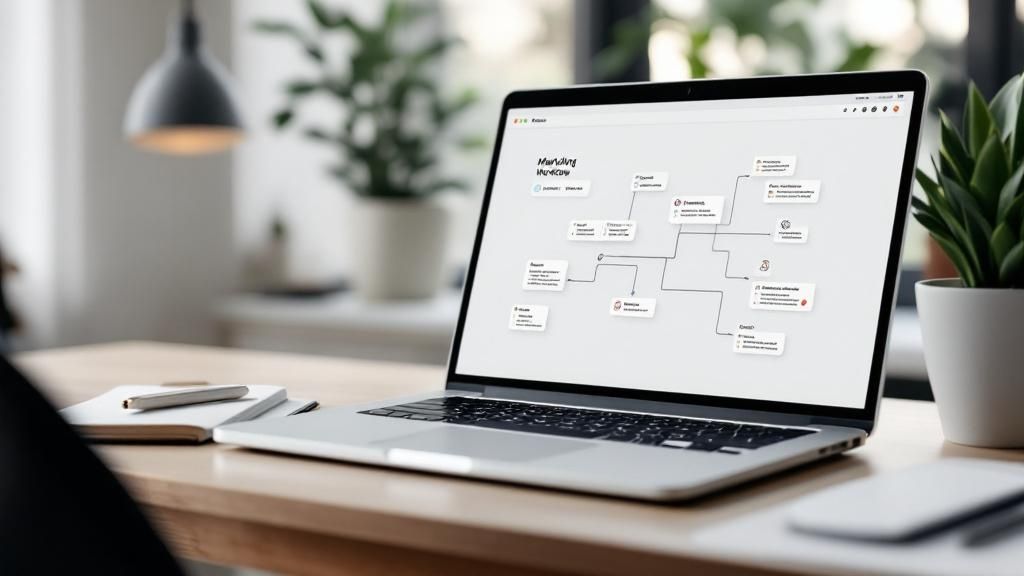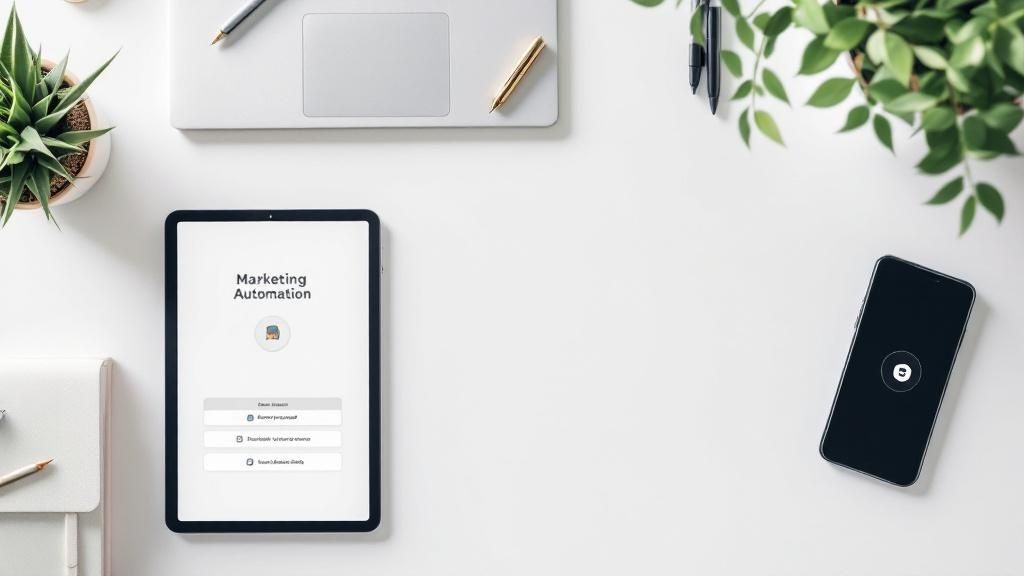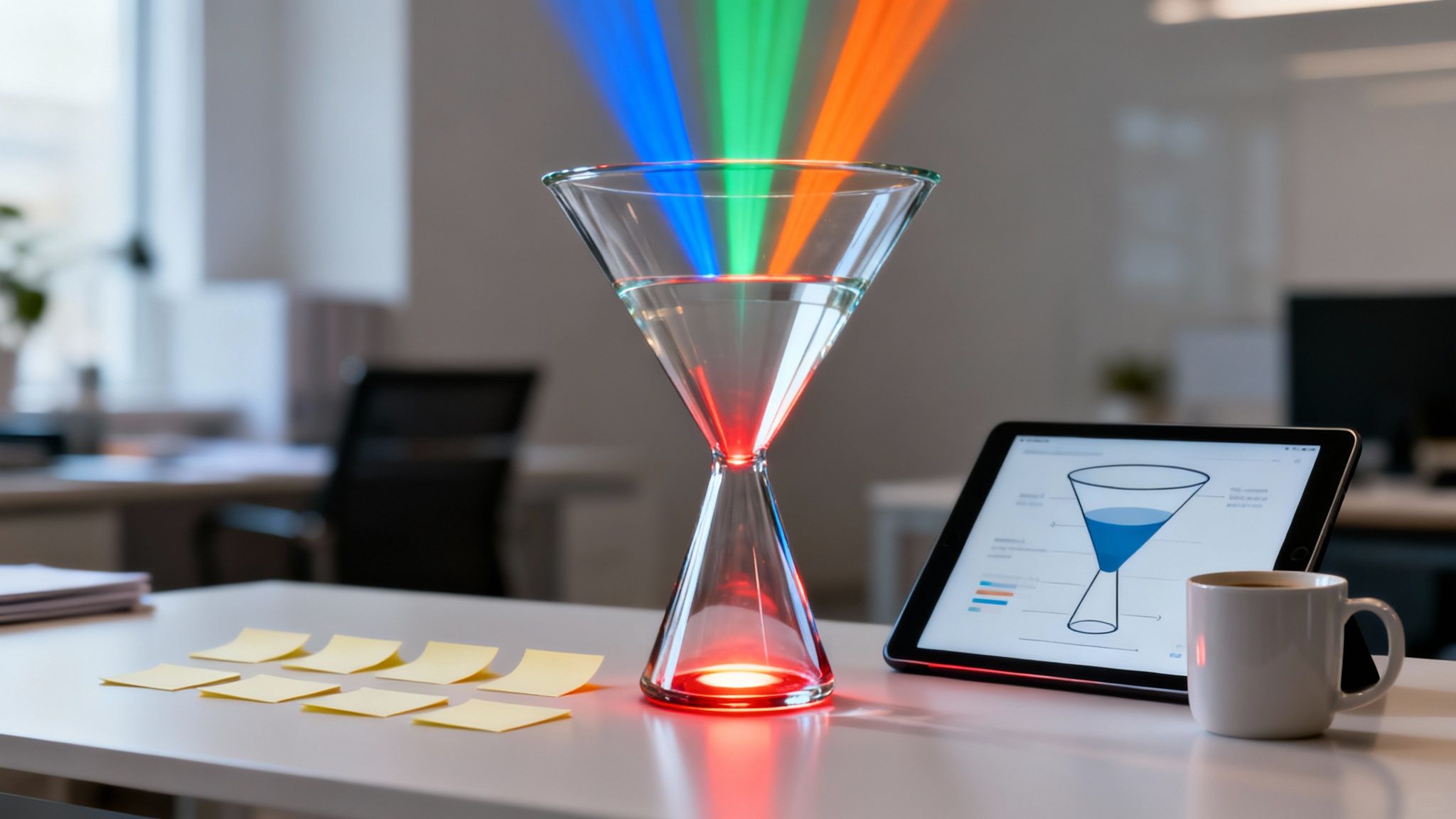Let's be honest: marketing involves a mountain of repetitive tasks. From sending follow-up emails to posting on social media and managing contact lists, it can feel like a never-ending cycle of busywork. This is where marketing workflow automation steps in—not as a complex piece of tech, but as your team's most valuable player.
At its core, it’s about using smart software to handle those time-consuming jobs automatically. This frees up your team to do what they do best: thinking creatively, strategizing, and building real connections with customers.
So, What Is Marketing Workflow Automation, Really?

Think of your marketing efforts as a complex machine with many moving parts—email, social media, your website, and paid ads. When you operate them all by hand, things get clunky. Messages get missed, follow-ups are forgotten, and the whole customer experience feels disjointed.
Marketing workflow automation acts as the central engine that connects all those parts. It ensures that every touchpoint—from the first welcome email to a targeted ad—happens at precisely the right time, creating a smooth, cohesive journey for your customer. It’s far more than just scheduling posts; it’s about building an intelligent system that guides people from curious prospects to loyal fans.
The Shift from Manual Grind to Automated Flow
Moving from manual tasks to automated systems isn't just a minor improvement; it's a monumental leap forward. The numbers don't lie. Automating workflows has been shown to boost marketing productivity by an impressive 14.5% while cutting overheads by 12.2%.
It's particularly powerful in email marketing, where companies using automation generate twice the number of leads and see a 58% bump in conversions compared to those still sending out manual email blasts.
The difference becomes crystal clear when you compare daily marketing tasks side-by-side.
Manual vs. Automated Marketing Tasks
Here’s a snapshot of how automation completely changes the game for common marketing activities, turning tedious chores into seamless, efficient processes.
As you can see, automation doesn't just save time; it creates a more responsive and personalized experience for your audience.
The Simple Logic Behind the Magic
So, how does it all work? At its core, marketing automation runs on a simple but powerful "if this, then that" logic. This is often called a trigger-and-action system.
A trigger is the specific event that kicks off an automated workflow. It could be anything: a user subscribing to your newsletter, abandoning their shopping cart, or visiting a specific pricing page.
Once that trigger event happens, the system performs an action. This is the "then that" part. The action could be sending a targeted email, updating a contact in your CRM, or even adding that user to a special audience for a new ad campaign.
While the software handles the execution, remember that a human is still in the driver's seat. Your strategy determines the triggers and actions. This human insight, often enhanced by artificial intelligence, is what turns a simple tool into a growth engine. To see how these technologies work hand-in-hand, check out our guide on AI in marketing.
The Real Payoff: What Marketing Automation Actually Does for Your Business

We've established what marketing workflow automation is, but the real question is, what’s in it for you? Why go through the effort of setting it all up?
The true value isn’t just about getting a fancy new piece of software. It’s a strategic decision to unlock efficiency, amplify your brand's voice, and build genuine customer relationships at a scale you could never manage by hand.
Think of it as taking all the repetitive, time-sucking tasks off your team's to-do list. This frees them up to focus on what humans do best: strategic thinking, creative problem-solving, and understanding market dynamics. That shift alone can have a massive impact on your bottom line.
Drive Real ROI and Supercharge Your Team
Let's talk numbers, because that's where the story gets really compelling. Adopting automation isn't just about feeling more productive; it has a direct, measurable impact on your return on investment (ROI).
According to research, companies that get this right see a 14.5% bump in sales productivity and a 12.2% drop in marketing overheads. This isn't just about saving a few dollars—it’s about reinvesting that time and money into work that actually grows the business.
When your team isn't buried in manual data entry or scheduling social posts one by one, they can focus on what matters. They can build better campaigns, analyze performance data, and find new ways to connect with customers. This is how you gain a real competitive edge.
Of course, to see that impact, you need to track the right things. If you need a refresher, our guide to mastering digital marketing performance metrics is a great place to start.
Keep Your Brand Message Rock-Solid and Consistent
In a noisy world, consistency is king. It’s how you build trust and become instantly recognizable. The problem? When everything is done manually, mistakes happen. An off-brand email goes out, a social media post misses the mark, or the timing is just plain wrong. This creates a choppy, disjointed experience for the customer.
Marketing workflow automation solves this by ensuring every single communication—from the first "hello" in a welcome email to a scheduled tweet—is perfectly on-brand and on time. It creates a seamless journey that reinforces who you are at every step.
This consistency yields several key advantages:
- Stronger Brand Trust: Customers receive a cohesive story across every channel, which makes your brand feel reliable and professional.
- A Better Customer Experience: A predictable and polished communication style makes every interaction feel smooth and intentional.
- Simplified Compliance: In regulated industries, automation is a lifesaver. It can automatically add required disclaimers or legal text to every communication, ensuring consistency and reducing risk.
Personalize the Customer Journey for Everyone, All at Once
This might be the biggest win of all. Automation gives you the power to deliver personalized experiences to your entire audience, no matter how large it gets. Today's customers expect you to understand their needs, interests, and history with your brand. Trying to do that by hand for thousands of people is impossible.
Automation makes it possible by using data to segment your audience intelligently. Then, it delivers exactly the right content based on user behavior, interests, and their stage in the customer journey.
Consider how this plays out in the real world:
- Smarter Lead Nurturing: A prospect browses your site, clicks emails, and downloads guides. An automated system tracks this, and once they hit a certain "engagement score," it instantly alerts a sales rep or sends a perfectly timed follow-up. Your sales team ends up talking to people who are genuinely interested and ready to engage.
- Dynamic Email Campaigns: Someone signs up for your software. They get a welcome series that adapts to their behavior. If they activate a key feature, the next email shows them advanced tips. If they haven’t logged in for a few days, it sends a friendly nudge with a helpful "getting started" video.
This is how you stop shouting at the crowd and start having thousands of one-on-one conversations simultaneously. It’s what makes every customer feel seen and understood, turning casual interest into lasting loyalty.
Building Your First Workflow: A Step-by-Step Guide
So, you're ready to build your first marketing workflow? It can feel like staring at a blank canvas, but getting started is much easier than it looks. The secret is to ignore the complex stuff for now and focus on a single, common task.
Let's walk through building a classic: the new newsletter subscriber welcome sequence. Think of this as learning your first few guitar chords. Once you master these, you can start stringing them together to create something much more impressive.
Step 1: Define the Trigger
Every automated workflow needs a starting pistol. That's your trigger. It’s the specific event that tells the system, "Go!" Without a precise trigger, your automation would be firing off at random.
For our example, the trigger is simple: a user successfully submits the newsletter signup form on your website.
That's it. It's a clean, deliberate action from a potential customer. Other common triggers could be:
- A shopper leaving items in their cart.
- Someone visiting your pricing page more than twice.
- A lead hitting a certain score in your CRM.
The trigger is the "if" in your workflow's "if this, then that" logic. It’s the starting block that kicks your automated process into gear.

As you can see, that initial form submission is just the first domino to fall in a fully connected system designed to nurture contacts and give you real-time feedback.
Step 2: Map the Sequence of Actions
Once your trigger fires, what happens next? You need to tell the system exactly what to do. This sequence of actions is the "then that" part of your plan. You’re essentially drawing a map for your new subscriber’s first few interactions with your brand.
Here’s a simple but powerful sequence for our welcome workflow:
- Immediate Action: Send a "Welcome" email. This should land in their inbox within minutes. It confirms their subscription and delivers any promised incentive, like a free ebook or discount code.
- Wait Period: Pause for three days. This is crucial. It gives them a chance to read the first email without being immediately bombarded, making the interaction feel more like a conversation.
- Follow-up Action: Send a second email. This time, you might share a few of your most-loved blog posts or ask about their interests. The goal is to add value, not just sell.
- Conditional Action: Now for some "if/then" logic. If the subscriber clicked a link in the second email, tag them as "highly engaged" in your CRM. If they didn't, no action is needed for now.
Just like that, you’ve turned a simple signup into the start of a real relationship without lifting a finger.
Step 3: Set a Clear End Goal
A workflow can't run forever. It needs a finish line—a clear end goal or exit point. This is the point at which the workflow has done its job. Having a defined goal prevents you from accidentally sending old, irrelevant messages and helps guide people to the next logical step.
A well-defined end goal ensures your automation serves a strategic purpose. It's not just about sending emails; it's about guiding a user toward a specific, valuable outcome for your business.
For our welcome series, the goal could be one of several things:
- The person clicks a link to a specific product page.
- They simply finish the whole email sequence.
- They make their first purchase.
Once they hit that goal, they "exit" this workflow. From there, they might move into a different automation—perhaps a long-term nurturing sequence or just your general monthly newsletter list.
This focus on goal-driven automation is precisely why 70% of marketing leaders are increasing their investment in these systems. They understand that automation is a must-have for winning and keeping customers, with 58% of decision-makers already automating email and 49% tackling social media. You can learn more about the rising tide of automation investment and its business impact.
By sticking to these three steps—trigger, sequence, and goal—you can build smart, automated systems that work for you 24/7, delivering marketing that feels personal and gets results.
Choosing the Right Automation Tools

You've got the concepts down and you understand how a marketing workflow should operate. Now you face the big question: "What software do I actually use for this?"
Picking the right tool is a critical decision that will define what your team can achieve for years. The market is flooded with options, each claiming to be the magic bullet. It’s easy to feel overwhelmed.
My advice: stop thinking of it as shopping for software. Instead, think of it as hiring a mission-critical team member. You need a platform that not only performs its job exceptionally well but also meshes with your team, has room to grow, and integrates with your existing tech stack.
Start by Looking in the Mirror, Not at Demos
Before you get dazzled by a slick feature or product demo, you have to do some internal homework. Don't skip this step.
The perfect automation platform for a Fortune 500 company will be a clunky, expensive mess for a growing small business. A tool built for a five-person startup will crumble under enterprise-level demand. So, get honest about where you are now and where you want to be.
Ask your team these questions:
- What’s our number one goal? Are we desperate for new leads? Do we need to improve at nurturing the ones we have? Is our customer onboarding process a mess? Your primary objective will instantly clarify which features are must-haves versus nice-to-haves.
- What’s our team’s real skill level? Be honest. Do you have a dedicated tech expert, or will your general marketing manager be setting everything up? The answer dramatically changes how much you should prioritize ease of use.
- How complex are our processes? Are you just automating a simple welcome email sequence? Or are you planning complex, multi-branching journeys that need to sync data between marketing, sales, and customer service?
Answering these questions first creates a powerful filter, allowing you to cross ill-fitting tools off your list and zero in on those that truly make sense for you.
Key Factors for Making a Smart Decision
Once you have a clear picture of your needs, you can start evaluating platforms with a consistent scorecard. This approach shifts the conversation from "Look at all the features!" to "How will this help us generate more revenue?"
Focus on these three non-negotiables:
Scalability: The tool you pick today needs to work for the company you’ll be tomorrow. Can it handle 10x your current contact list without the price exploding or performance grinding to a halt? A scalable platform means you won't face a painful and risky migration process in two years.
Integration Capability: Your automation tool cannot live on an island. Its ability to communicate with your other core systems—especially your CRM (like Salesforce or Dynamics 365), e-commerce store, and analytics software—is absolutely critical. Poor integrations create data silos and more manual work, defeating the purpose of automation.
Analytics and Reporting: If you can't measure it, you can't improve it. The platform must provide clear, actionable data on how your workflows are performing. Look for easy-to-read dashboards, custom reports, and the ability to track metrics that actually matter (like conversion rates and ROI), not just vanity metrics like email opens.
Your marketing workflow automation software should be the central hub of your marketing technology, not just another isolated tool. Its ability to connect systems and provide clear data is just as important as its ability to send an email.
Comparing Popular Marketing Automation Platforms
To give you a better sense of how this plays out in the real world, let's look at a few of the big players. This table isn't meant to be exhaustive, but it will give you a strategic starting point for your own research by showing who each tool is really built for.
Comparing Popular Marketing Automation Platforms
An evaluation of leading marketing automation tools based on target audience, key features, and integration capabilities.
As you can see, the "best" tool is completely dependent on your situation. A small e-commerce brand would get incredible value from ActiveCampaign's nimble automation. On the other hand, a massive B2B corporation would need the raw power of a tool like Marketo to run its complex account-based marketing plays.
By following this structured approach, you can cut through the marketing fluff and confidently choose a platform that will truly become a growth engine for your business.
Advanced Automation Strategies and Best Practices
Once you’ve mastered the basics, this is where marketing workflow automation really starts to shine. Moving past simple welcome emails and into more advanced strategies is how you build a real, sustainable competitive advantage.
We're talking about transforming your marketing from a set of disconnected tasks into an intelligent, orchestrated system that anticipates customer needs. It’s the difference between blasting a generic email and dynamically changing the content based on what a user just did on your website. This is where execution becomes mastery.
Orchestrate Multi-Channel Campaigns
The modern customer journey is messy. It zigs and zags across different channels. A prospect might see your ad on social media, visit your site, sign up for your newsletter, and then finally talk to a sales rep. An advanced automation strategy is the thread that ties all these touchpoints together into one seamless conversation.
Imagine a user clicks a Facebook ad for a specific product. A sophisticated workflow can kick in and immediately:
- Add them to a targeted email sequence focused on that product category.
- Start showing them retargeting ads on other platforms that highlight related features.
- Notify a sales rep if that same user visits the pricing page more than once.
This creates a smooth, logical experience where every message builds on the last, gently guiding the customer through their decision. The impact of getting this right is massive. Companies that master this report an 80% increase in leads and a 75% boost in conversions. You can explore the full findings on workflow automation statistics to see the detailed breakdown.
Leverage AI for Predictive Insights
If automation is your engine, then artificial intelligence is the supercharger. Traditional automation excels at following pre-set "if this, then that" rules. But AI adds a layer of predictive intelligence, allowing the system to make smart decisions on its own.
One of the most powerful applications is predictive lead scoring. Instead of manually assigning points for actions (e.g., +5 for an email open), an AI model analyzes data from thousands of past customers. It learns the subtle behavioral patterns of your best leads and then scores new prospects in real-time based on their likelihood to convert. This ensures your sales team is always focused on the hottest opportunities.
AI-powered automation doesn’t just do things faster; it makes your entire marketing strategy smarter. You stop reacting to what customers did and start anticipating what they’ll do next.
Implement Dynamic Content Personalization
This is where personalization gets truly powerful. Dynamic content allows a single email or landing page to show different images, headlines, or calls-to-action depending on who is viewing it. We're way beyond just using a contact's first name here.
For an e-commerce brand, this is a game-changer. A customer who previously bought running shoes could receive an email showcasing new athletic apparel. Meanwhile, a brand-new visitor might see a "bestsellers" section instead. This granular personalization is a massive driver for engagement and sales. As you build out these journeys, our guide on how eCommerce SEO boosts visibility and sales can offer valuable insights.
Crucial Best Practices for Long-Term Success
Building these advanced workflows is only half the job. Maintaining them is what separates the pros from the amateurs and guarantees you see results for years to come.
Always keep these best practices front and center:
- Prioritize Data Hygiene: Your automation is only as smart as the data you feed it. Regularly clean your contact lists, standardize data fields, and remove inactive or duplicate records. Remember the golden rule: garbage in, garbage out.
- Conduct Regular Audits: Don't just "set it and forget it." At least once a quarter, review your active workflows. Are they still aligned with your business goals? Are the engagement rates still strong? A workflow that was effective last year might be underperforming today.
- Maintain the Human Element: Automation should empower your team, not replace it. The best strategies always have a human overseeing the system, analyzing results, and providing the creative and strategic brainpower a machine cannot replicate.
Your Top Automation Questions, Answered
As you dig into marketing workflow automation, questions are bound to arise. It’s one thing to understand the concept, but it’s another to see how it fits into your daily business operations. Getting this right is what separates a decent automation setup from a truly great one.
Think of this as your final pre-flight check. We've talked about the what, why, and how. Now, let's tackle those lingering questions so you can launch your automation strategy with total confidence.
How Do I Know If My Business Is Ready for Automation?
This is an excellent question. The most obvious sign is seeing your team get swamped by repetitive, manual tasks. If their days are filled with sending follow-up emails one by one, manually posting to social media, or updating lead statuses in a spreadsheet, you’re more than ready.
Another dead giveaway is when you’re struggling to give a growing audience a personal touch. Do your customer communications feel generic? Are you sitting on a pile of leads you can't seem to qualify or nurture effectively? That's your cue. And don't mistake this for a "big company" tool—even solo entrepreneurs use automation to punch way above their weight class.
It's less about your company's size and more about your process maturity. If you have defined marketing processes and a solid understanding of your customer's journey, you are in the perfect spot to start automating.
What Is the Difference Between Marketing Automation and a CRM?
This is a huge point of confusion, but the distinction is critical. Your CRM and marketing automation software are two sides of the same coin—powerful partners, but with different jobs.
A Customer Relationship Management (CRM) platform is your system of record. Think of it as your digital command center for every customer interaction. It holds all your contact information, communication logs, and sales pipeline data.
Marketing automation software, on the other hand, is the system of action. It’s the engine that does things with all that rich CRM data. It runs your email campaigns, scores leads based on their activity, and guides prospects through the sales funnel automatically.
To put it simply:
- CRM (like Salesforce or Dynamics 365): This is the "who" and the "what happened."
- Marketing Automation: This powers the "what happens next."
The magic happens when you integrate them tightly. Data flows back and forth, giving you a complete, unified picture of every single customer.
Can Marketing Automation Feel Too Robotic?
This is a completely valid fear. And honestly, when done badly, it absolutely feels robotic and impersonal. We’ve all received those generic, tone-deaf emails.
But the real goal of modern automation is the exact opposite: to enable personalization at scale. A smart automation strategy uses customer data—like what they’ve bought, which pages they’ve visited, or how often they open your emails—to send messages that are incredibly relevant and timely.
This is how you automatically send a customer a personalized birthday discount, remind them about the specific items they left in their shopping cart, or share content that aligns with their interests. Trying to pull that off manually for thousands of people is impossible. The key isn't to blast messages; it's to design thoughtful workflows that anticipate needs and add real value, making the customer feel understood, not just marketed to.
What Are the Most Common Mistakes to Avoid When Starting?
Diving into automation without a solid plan is a recipe for frustration. A few common missteps trip people up all the time. Here’s what to watch out for:
- Automating a Broken Process: This is the single biggest mistake. If your current marketing strategy isn't working, automating it just means you’ll fail faster and on a much bigger scale. You must map out and fix your manual process first.
- Ignoring Data Hygiene: Your automation is only as good as the data feeding it. If your contact lists are a mess of outdated or incorrect info, your workflows will stumble. The "garbage in, garbage out" rule is non-negotiable here. Make data cleanup a regular habit.
- Lacking Clear Goals: If you don't define what success looks like, how will you know if your automation is even working? Before you build anything, decide on your goals and the Key Performance Indicators (KPIs) you'll use to track them.
- Having a 'Set It and Forget It' Mindset: Your job isn’t over once you press "go." The best results come from constantly monitoring your workflows, A/B testing elements like subject lines and timing, and optimizing based on what the data tells you.
Sidestep these common pitfalls, and you'll be on the right track for building an automation engine that delivers a real, measurable return for your business.
Ready to stop guessing and start growing? Twelverays is an award-winning digital marketing and CRM agency that builds data-driven automation strategies tailored to your unique business goals. We specialize in integrating platforms like Dynamics 365 and Salesforce to create seamless workflows that drive real revenue. Discover how we can elevate your marketing performance.





